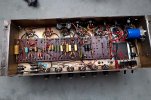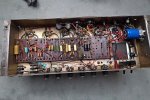LPman
Well-Known Member
- Joined
- Apr 3, 2016
- Messages
- 242
- Reaction score
- 437
It's an old JMP amp. After playing for 30 mins at very high volume, the amp starts acting up. Volume is fading out, than crackling and popping noises appear. When I give a small knock with a pencil at the V1 preamp tube, the popping stops and sound comes back. Then after playing for 5 mins it starts again. The next day, it's the same - the amp is good for half an hour than it craps out. Tried changing V1 tubes, cleaning the V1 socket but no luck.
Before this problem started, I brought the amp to my tech and we modified the preamp plate voltage by bypassing one of the 10K dropping resistors that are next to the two bias filter caps (as it is on factory 2204's - only one 10k resistor). After that, the PI tube voltage increased to 340 V. My tech said that it shouldn't be a problem. Could this somehow be the culprit of V1 acting up suddenly or no correlation? Any ideas what to look for next?
Before this problem started, I brought the amp to my tech and we modified the preamp plate voltage by bypassing one of the 10K dropping resistors that are next to the two bias filter caps (as it is on factory 2204's - only one 10k resistor). After that, the PI tube voltage increased to 340 V. My tech said that it shouldn't be a problem. Could this somehow be the culprit of V1 acting up suddenly or no correlation? Any ideas what to look for next?



